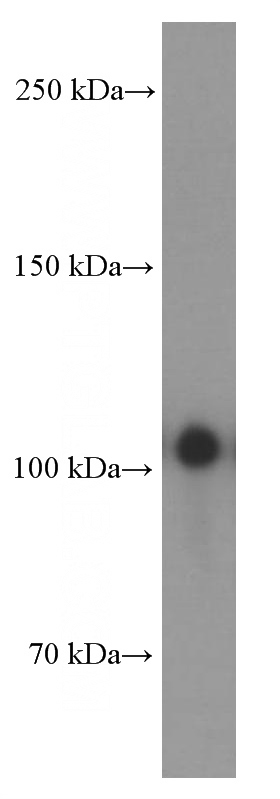-
Product Name
EPHA1-specific antibody
- Documents
-
Description
EPHA1-specific Mouse Monoclonal antibody. Positive WB detected in HeLa cells, COLO 320 cells, HepG2 cells. Observed molecular weight by Western-blot: 108 kDa
-
Tested applications
ELISA, WB
-
Species reactivity
Human; other species not tested.
-
Alternative names
EPH antibody; EPH receptor A1 antibody; EPHA1 antibody; Ephrin type A receptor 1 antibody; EPHT antibody; EPHT1 antibody
-
Isotype
Mouse IgG1
-
Preparation
This antibody was obtained by immunization of Peptide (Accession Number: NM_005232). Purification method: Caprylic acid/ammonium sulfate precipitation.
-
Clonality
Monoclonal
-
Formulation
PBS with 0.1% sodium azide and 50% glycerol pH 7.3.
-
Storage instructions
Store at -20℃. DO NOT ALIQUOT
-
Applications
Recommended Dilution:
WB: 1:1000-1:10000
-
Validations

HeLa cells were subjected to SDS PAGE followed by western blot with Catalog No:107255(EPHA1-special Antibody) at dilution of 1:3000
-
Background
EPHA1, also named as EPH, EPHT and EPHT1, belongs to ephrin receptor subfamily of the protein-tyrosine kinase family. EPH and EPH-related receptors have been implicated in mediating developmental events, particularly in the nervous system. Receptors in the EPH subfamily typically have a single kinase domain and an extracellular region containing a Cys-rich domain and 2 fibronectin type III repeats. Ligands in the ephrin-A subclass, including the prototype family member ephrin-A1 (B61), are membrane associated through glycosylphosphatidyl-inositol linkages, whereas ephrin-B subclass consists of ligands with transmembrane domains. The general role of the Eph family is in mediating repulsive cell-cell interaction.
Related Products / Services
Please note: All products are "FOR RESEARCH USE ONLY AND ARE NOT INTENDED FOR DIAGNOSTIC OR THERAPEUTIC USE"
